EDitorial Comments
A. Merritt’s BURN WITCH BURN, MGM’s Film Version, THE DEVIL DOLL
I enjoy comparing famous fictional works to films adapted from them. Over the weekend I revisited A. Merritt’s Burn, Witch, Burn! (1932) for the first time in more than 30 years. I finished re-reading it on Monday night, so last night I screened The Devil-Doll, its 1936 movie version, for the first time in nearly two decades. The comparison was instructive. I’m not going to give you a scene-for-scene description of either, mostly because I plan on saving that for the “Pulp Page to Silver Screen” installment in the next issue of Blood ‘n’ Thunder. But a few points are worth mentioning here, just for fun.
Merritt’s 1932 horror story — first published as a serial in Argosy, then in hard covers by Liveright — is told in the first person by a neurologist who uses the pseudonym of Dr. Lowell for reasons that “will become increasingly apparent as my recital progresses.” One night, in his New York hospital, Lowell attempts to treat a patient associated with “notorious underworld chieftain” Julian Ricori. This man, whom Ricori identifies as Thomas Peters, has collapsed for no reason and seems to exist in a twilight state, neither conscious nor unconscious, a look of unutterable terror in his eyes. His professional curiosity aroused, Lowell agrees to do what he can for the gangster despite puzzling limitations placed on him by Ricori.
Peters ultimately succumbs and the baffled neurologist finds himself drawn into a battle of wills between Ricori and one Madame Mandilip, whom the underworld boss believes to be a witch. Her eerily realistic dolls figure prominently in the story’s action and Lowell, despite his scientific grounding, comes to believe that black magic is being employed.
Burn, Witch, Burn! was the first Merritt yarn I ever read, and I’ve always thought it one of his most accessible novels. It’s held up extremely well, I think, although a few false notes still ring out. The various gangsters depicted at length seem a trifle too articulate and intelligent, not to mention loyal and cooperative. And the neurologist’s repeated insistence on disbelieving the evidence of his own eyes becomes downright annoying after he witnesses the fifth or sixth “impossible” occurrence. But Merritt skillfully conveys and sustains an atmosphere of horror, a death-from-everywhere sense of impending doom and unfathomable evil.
Tod Browning, one of the early cinema’s masters of the macabre, was no stranger to pulp fiction. Two — actually, three — of his previous hits, The Unholy Three (1925, remade in 1930) and Freaks (1932), were adapted from Tod Robbins stories originally published in All-Story Weekly and Munsey’s Magazine, respectively. Browning assiduously scoured the pages of rough-paper magazines for terrorific tales he could bring to the screen, although he’s best remembered for Dracula (1931), a loose adaptation of Bram Stoker’s novel and the play adapted from it by Hamilton Deane and John L. Balderston. It was to Garrett Fort, one of his collaborators on Dracula‘s screenplay, that Browning turned after persuading M-G-M to let him film Merritt’s novel. By rights, Burn, Witch, Burn! should have gone to Universal, Hollywood’s most prominent house of horrors, but Browning had just scored big for Metro with Mark of the Vampire (1935), which featured Dracula‘s Bela Lugosi in a part similar to his star-making role.
Three writers get screen credit for The Devil-Doll, as the Merritt adaptation was finally called: Fort, Guy Endore (author of The Werewolf of Paris and a prolific scenario scribe), and Erich von Stroheim (the legendarily eccentric actor-director, billed here as Eric). But additional dialogue and story elements were contributed by Richard Schayer (who wrote the screenplays for Universal’s first Frankenstein and Mummy movies) and Browning himself. The film — which starred Lionel Barrymore, Maureen O’Sullivan, and a host of distinguished character actors — was given top-flight production mounting and boasted some impressive special effects. Released in the summer of 1936, it was dismissed by most critics and did only fair business.
Again, I don’t want to go into detail where the story in concerned. The Devil-Doll is commercially available on DVD and plays regularly on Turner Classic Movies, so you can see it without much trouble if you’re of a mind to do so. But it’s worth noting how thoroughly — and skillfully — Browning and company transformed Burn, Witch, Burn! They retained a key plot device but completely replaced the yarn’s tone, settings, characters, and sequence of events. Perhaps most importantly, they removed every hint of the supernatural and substituted the science-fictional (none too convincingly, it should be said). I’ll save a discussion of the most intriguing plot alteration for the Blood ‘n’ Thunder article. Suffice to say that both book and film are eminently satisfying, but for wildly different reasons.
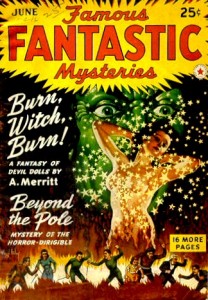 By the way, for my re-reading of Burn, Witch, Burn! I turned to the June 1942 issue of Famous Fantastic Mysteries, which reprints the entire novel in 89 pages. I have the 1932 issues of Argosy that present the story in serialized form, but I wanted to revisit Merritt’s yarn in the version featuring a great cover and interior illustrations by Virgil Finlay. This particular pulp magazine is neither difficult nor expensive to obtain, and it reprints several other great stories to boot, including Irvin S. Cobb’s classic “Fishhead.” You collectors out there who don’t have a copy might want to add this issue to your want lists.
By the way, for my re-reading of Burn, Witch, Burn! I turned to the June 1942 issue of Famous Fantastic Mysteries, which reprints the entire novel in 89 pages. I have the 1932 issues of Argosy that present the story in serialized form, but I wanted to revisit Merritt’s yarn in the version featuring a great cover and interior illustrations by Virgil Finlay. This particular pulp magazine is neither difficult nor expensive to obtain, and it reprints several other great stories to boot, including Irvin S. Cobb’s classic “Fishhead.” You collectors out there who don’t have a copy might want to add this issue to your want lists.
26 thoughts on “A. Merritt’s BURN WITCH BURN, MGM’s Film Version, THE DEVIL DOLL”
Leave a Reply
Recent Posts
- Windy City Film Program: Day Two
- Windy City Pulp Show: Film Program
- Now Available: When Dracula Met Frankenstein
- Collectibles Section Update
- Mark Halegua (1953-2020), R.I.P.
Archives
- March 2023
- July 2021
- May 2021
- March 2020
- February 2020
- December 2019
- November 2019
- October 2019
- September 2019
- August 2019
- May 2019
- April 2019
- March 2019
- February 2019
- December 2018
- November 2018
- October 2018
- August 2018
- June 2018
- February 2018
- December 2017
- October 2017
- September 2017
- August 2017
- May 2017
- April 2017
- February 2017
- September 2016
- August 2016
- July 2016
- June 2016
- November 2015
- October 2015
- September 2015
- August 2015
- July 2015
- June 2015
- May 2015
- April 2015
- March 2015
- February 2015
- January 2015
- August 2014
- July 2014
- June 2014
- May 2014
- April 2014
- January 2014
- December 2013
- September 2013
- August 2013
- July 2013
- June 2013
- May 2013
- April 2013
- March 2013
- February 2013
- January 2013
- December 2012
- October 2012
- September 2012
- August 2012
- July 2012
- June 2012
- May 2012
Categories
- Birthday
- Blood 'n' Thunder
- Blood 'n' Thunder Presents
- Classic Pulp Reprints
- Collectibles For Sale
- Conventions
- Dime Novels
- Film Program
- Forgotten Classics of Pulp Fiction
- Movies
- Murania Press
- Pulp People
- PulpFest
- Pulps
- Reading Room
- Recently Read
- Serials
- Special Events
- Special Sale
- The Johnston McCulley Collection
- Uncategorized
- Upcoming Books
- Western Movies
- Windy City pulp convention
Dealers
Events
Publishers
Resources
- Coming Attractions
- Field Guide to Wild American Pulp Artists
- MagazineArt.Org
- Mystery*File
- ThePulp.Net

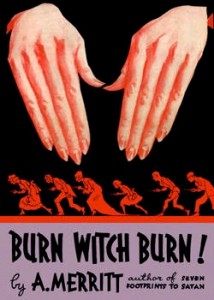


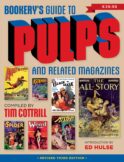
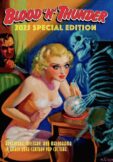
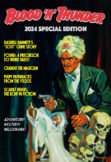
Nice article Ed. You reminded me how much I love the early issues of FFM. I have enjoyed all of A. Merritt’s work but my favorite has to be The Ship of Ishtar. First read that one darn near 40 years ago.